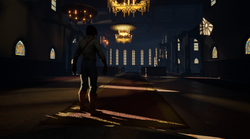
Remnant's Hope

3D Adventure Exploration Game | Solo Project | January 2024 | Unreal Engine 5
Remnant's Hope is an open world and open ended adventure exploration game, featuring rewarding exploration, fun platforming mechanics, and an engaging story!
Play time: 15mn - 45mn
Branching Character Dialogue
Format: Script
~8200 words
 |  |  |
|---|---|---|
 |  |
Game Description
Remnant's Hope is a open world and open ended adventure exploration game, featuring rewarding exploration, fun platforming mechanics, and an engaging story!
Story
You've reached the day where most young boys come of age in your village... For the fourth year in a row. You need to go around your small village of Remnant's Hope and help the villagers so that they will give you their bonds of faith, signifying that you're responsible enough to go adventuring! You'll have to convince them tough, they don't think much of you...
World Layout





Sketches
The original idea of this game was to be an open world centered around a hub, with three main quests, sidequests and pick ups spread around. Originally, the three main quests revolved in the village, and outside was very empty. Through playtesting, I realized this would not encourage exploration, and decided to spread the objectives and main quests throughout the world, and place the sidequests in their paths.
Prototyping
I spent a long time tweaking and playtesting the platforming mechanics to ensure they would be simple, yet fun. After playing around with multiple asset packs, I understood that blueprinting my own while following tutorials and using small exterior components would give me the most control over it. While I wanted platforming to be challenging, I found it stood in the way of free exploration, and I streamlined it to its simplest components. A huge learning experience was the first playtest, when I realized that the actual player movement didn't matter as much as the camera movement, its placement, in the game feel!




Early World Design




My original designs for the world involved using the entire default size of an Unreal Engine landscape, and building the level from there. Admittedly, not very thoughtful. I realized that players got bored quickly while exploring it, no matter how fast they could go, that I didn't have enough content to fill it up with, and that such size was overscoped in the time I had. I chose to cut the map in half, surround it by seas and mountains, and fill up the remaining half with closer knit content. It made exploration more interesting, and had the added benefit of making the environment look more natural, and help with optimization!
Sight lines
I designed the environment to ensure that each point of interest had a direct sightline to at least two other ones.





The reasoning was to let the player see every main objectives location as soon as they exited the tavern.

Well in the foreground, Town Hall in the middle ground, and church in the background, lit up by the rising sun all the way back.

Path in the foreground, cemetery in middle ground, mountain path and ruins in the background.

The reasoning was to let the player see every main objectives location as soon as they exited the tavern.
Depth
Drawing from my film education, I made ensured that as many view point had at foreground, middleground, and background to it, while attaching points of interest to each, to help give the environment a sense of life and depth.
For example, where the church used to be next to the Town Hall, I moved it up and behind it to create that depth.

"TRACKS! Where do they go?" - Gabriella Lopez

"Oooh! Pretty! Pretty!" - Peyton Briska

"I thought I'd follow the river upstream to find the deer" - Winson

"TRACKS! Where do they go?" - Gabriella Lopez
Hints & breadcrumbs
In order for the player never to find themselves in a position where they didn't know where to go, I made sure to hint at important places by making them stand out visually, or, if I couldn't, placing "breadcrumbs" in the environment to lead the player there.




Vertical Level Design
While underground areas were always a part of the plan, the newly cut map included mountains, which I felt would be a shame not to use to create upwards verticality as well. I chose to remove any fall damage or fall death, to avoid punishing the player for trying things out, and not to frustrate them in their exploration.



